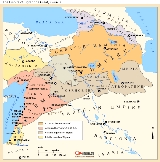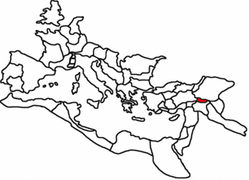
Sophene
Encyclopedia
Sophene , or , Fourth Armenia) was a province of the Armenian Kingdom and of the Roman Empire
, located in the south-west of the kingdom. It currently lies in modern-day southeastern Turkey
.
The region that was to become Sophene was part of the kingdom of Ararat
(Urartu) in the 8th-7th centuries BC. After unifying the region with his kingdom in the early 700s BC, king Argishtis I of Urartu
resettled many of its inhabitants to his newly built city of Erebuni
(modern day Armenian capital Yerevan
). Around 600 BC, Sophene became part of the newly emerged ancient Armenian Kingdom of the Orontids
.
According to Anania Shirakatsi
's Ashkharatsuyts ("World Atlas," 7th century), Tsopk (Sophene) was the 2nd among the 15 provinces of Greater Armenia. It consisted of 8 cantons (gavars):
After Alexander the Great's campaigns in 330s BC and the subsequent collapse of the Achaemenid Empire
, Sophene remained part of the newly independent kingdom of Greater Armenia. In the early 200s BC, at the instigation of the Seleucid Empire, which was trying to weaken the Armenian kingdom, Sophene, split from Greater Armenia, forming the Kingdom of Sophene
. The kingdom was ruled by a branch of the Armenian royal dynasty of Orontids
. Sophene later split from the Sophene-Commagene kingdom as well, forming an independent kingdom. Commagene was part of Sophene at this time.
Around 200 BC, in his attempt to finally subjugate Armenia, Seleucian king Antiochus III conquered both Greater Armenia and Sophene, installing Armenian generals Artaxias I
and Zariadres
as governors-strategoses respectively in each kingdom. Following Antiochus' defeat by Romans at the battle of Magnesia in 190 BC, both Zareh and Artashes declared themselves independent kings. Zareh and his descendants ruled the kingdom of Sophene until it was reunified with Greater Armenia by Tigranes the Great
in the 80s BC.
 Pompey
Pompey
gave Sophene to Tigranes
, after defeating his father Tigranes the Great
.
Sophene later become part of the Roman Empire, and was made into a province
of the Roman Empire
. The capital was Amida
(modern Diyarbakır
). Around 54
, the province was ruled by Sohaemus of Emesa
.
In 530, Sophene was included into the province of Armenia IV.
Armenian population remained until 1915's Armenian Genocide
.
Roman Empire
The Roman Empire was the post-Republican period of the ancient Roman civilization, characterised by an autocratic form of government and large territorial holdings in Europe and around the Mediterranean....
, located in the south-west of the kingdom. It currently lies in modern-day southeastern Turkey
Turkey
Turkey , known officially as the Republic of Turkey , is a Eurasian country located in Western Asia and in East Thrace in Southeastern Europe...
.
The region that was to become Sophene was part of the kingdom of Ararat
Urartu
Urartu , corresponding to Ararat or Kingdom of Van was an Iron Age kingdom centered around Lake Van in the Armenian Highland....
(Urartu) in the 8th-7th centuries BC. After unifying the region with his kingdom in the early 700s BC, king Argishtis I of Urartu
Argishtis I of Urartu
Argishti I was the sixth known king of Urartu, reigning from 785 BC to 763 BC. He founded the citadel of Erebuni in 782 BC, which is the present capital of Armenia, Yerevan....
resettled many of its inhabitants to his newly built city of Erebuni
Erebuni
Erebuni may refer to:*Erebuni Fortress, the fortress of ancient kingdom of Urartu, now territory of Armenia*Yerevan, capital of Armenia*Erebuni, Armenia, a district of Yerevan*Erebuni Museum*Erebuni Airport...
(modern day Armenian capital Yerevan
Yerevan
Yerevan is the capital and largest city of Armenia and one of the world's oldest continuously-inhabited cities. Situated along the Hrazdan River, Yerevan is the administrative, cultural, and industrial center of the country...
). Around 600 BC, Sophene became part of the newly emerged ancient Armenian Kingdom of the Orontids
Orontid Dynasty
The Orontid Dynasty The Orontid Dynasty The Orontid Dynasty (also known by their native name, Yervanduni was a hereditary Armenian dynasty and the rulers of the successor state to the Iron Age kingdom of Ararat...
.
According to Anania Shirakatsi
Anania Shirakatsi
Anania Shirakatsi was an Armenian mathematician, astronomer and geographer. He is commonly attributed to having written the Geography .-Life:Scholars are split on where exactly Anania was born...
's Ashkharatsuyts ("World Atlas," 7th century), Tsopk (Sophene) was the 2nd among the 15 provinces of Greater Armenia. It consisted of 8 cantons (gavars):
- Khordzyan
- Hashtyank
- Paghnatun
- BalahovitBalahovitBalahovit is a town in the Kotayk Province of Armenia.- References :* – World-Gazetteer.com...
- Tsopk (Shahunyats)
- Andzit,
- DegiqDegiqDegiq was a region and a family of the old Armenia c. 300–800....
- Gavreq (Goreq).
After Alexander the Great's campaigns in 330s BC and the subsequent collapse of the Achaemenid Empire
Achaemenid Empire
The Achaemenid Empire , sometimes known as First Persian Empire and/or Persian Empire, was founded in the 6th century BCE by Cyrus the Great who overthrew the Median confederation...
, Sophene remained part of the newly independent kingdom of Greater Armenia. In the early 200s BC, at the instigation of the Seleucid Empire, which was trying to weaken the Armenian kingdom, Sophene, split from Greater Armenia, forming the Kingdom of Sophene
Kingdom of Sophene
The Kingdom of Sophene was an ancient Armenian kingdom. Founded around the 3rd century BC the kingdom maintained independence until 90s BC when Tigranes the Great conquered these territories as part of his empire...
. The kingdom was ruled by a branch of the Armenian royal dynasty of Orontids
Orontid Dynasty
The Orontid Dynasty The Orontid Dynasty The Orontid Dynasty (also known by their native name, Yervanduni was a hereditary Armenian dynasty and the rulers of the successor state to the Iron Age kingdom of Ararat...
. Sophene later split from the Sophene-Commagene kingdom as well, forming an independent kingdom. Commagene was part of Sophene at this time.
Around 200 BC, in his attempt to finally subjugate Armenia, Seleucian king Antiochus III conquered both Greater Armenia and Sophene, installing Armenian generals Artaxias I
Artaxias I
Artaxias I was the founder of the Artaxiad Dynasty whose members ruled the Kingdom of Armenia for nearly two centuries....
and Zariadres
Zariadres
Zariadres was a King of Sophene.Strabo cites Sophene being taken over by a "general" of king Antiochus III by 200 BC, called Zariadres.Following the defeat of Antiochus III by the Romans at the Battle of Magnesia in 190 BC, Zariadres and Artaxias* revolted and with Roman consent began to reign...
as governors-strategoses respectively in each kingdom. Following Antiochus' defeat by Romans at the battle of Magnesia in 190 BC, both Zareh and Artashes declared themselves independent kings. Zareh and his descendants ruled the kingdom of Sophene until it was reunified with Greater Armenia by Tigranes the Great
Tigranes the Great
Tigranes the Great was emperor of Armenia under whom the country became, for a short time, the strongest state east of the Roman Republic. He was a member of the Artaxiad Royal House...
in the 80s BC.

Pompey
Gnaeus Pompeius Magnus, also known as Pompey or Pompey the Great , was a military and political leader of the late Roman Republic...
gave Sophene to Tigranes
Tigranes
Tigranes was the name of a number of historical figures, primarily kings of Armenia.The earliest Tigranes is mentioned in the Cyropaedia and in Armenian historical sources. He was an Armenian king from the Orontid Dynasty and an ally of Cyrus the Great. One of his sons was also named Tigranes...
, after defeating his father Tigranes the Great
Tigranes the Great
Tigranes the Great was emperor of Armenia under whom the country became, for a short time, the strongest state east of the Roman Republic. He was a member of the Artaxiad Royal House...
.
Sophene later become part of the Roman Empire, and was made into a province
Roman province
In Ancient Rome, a province was the basic, and, until the Tetrarchy , largest territorial and administrative unit of the empire's territorial possessions outside of Italy...
of the Roman Empire
Roman Empire
The Roman Empire was the post-Republican period of the ancient Roman civilization, characterised by an autocratic form of government and large territorial holdings in Europe and around the Mediterranean....
. The capital was Amida
Amida (Roman city)
Amida was an ancient city located where modern Diyarbakır, Turkey. The Roman writers Ammianus Marcellinus and Procopius consider it a city of Mesopotamia, but it may be more properly viewed as belonging to Armenia Major....
(modern Diyarbakır
Diyarbakır
Diyarbakır is one of the largest cities in southeastern Turkey...
). Around 54
54
Year 54 was a common year starting on Tuesday of the Julian calendar. At the time, it was known as the Year of the Consulship of Lentulus and Marcellus...
, the province was ruled by Sohaemus of Emesa
Sohaemus of Emesa
Gaius Julius Sohaemus, also known as Sohaemus of Emesa and Sohaemus of Sophene , was a prince and a Roman Client Priest King from Syria who lived in the 1st century....
.
In 530, Sophene was included into the province of Armenia IV.
Armenian population remained until 1915's Armenian Genocide
Armenian Genocide
The Armenian Genocide—also known as the Armenian Holocaust, the Armenian Massacres and, by Armenians, as the Great Crime—refers to the deliberate and systematic destruction of the Armenian population of the Ottoman Empire during and just after World War I...
.

